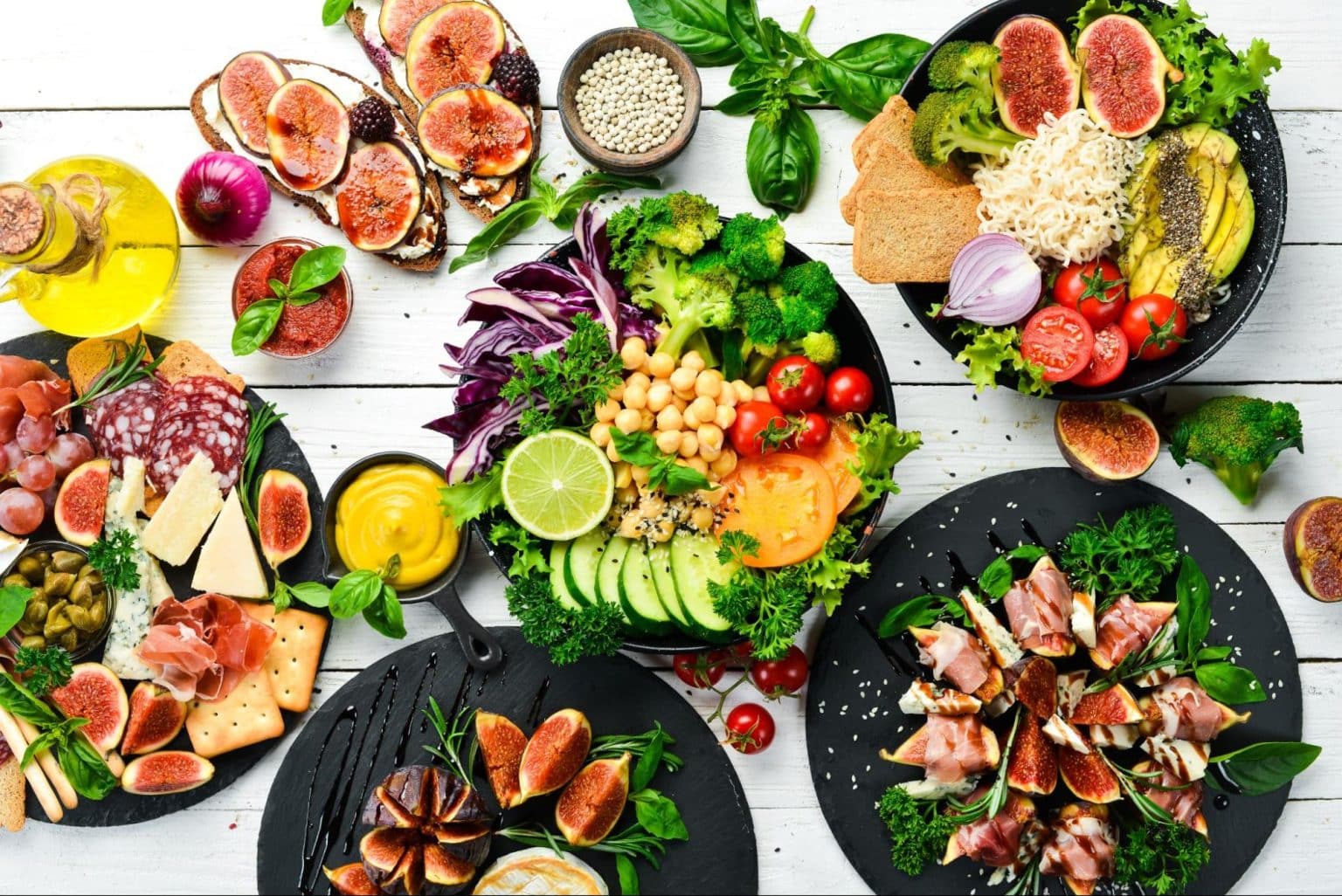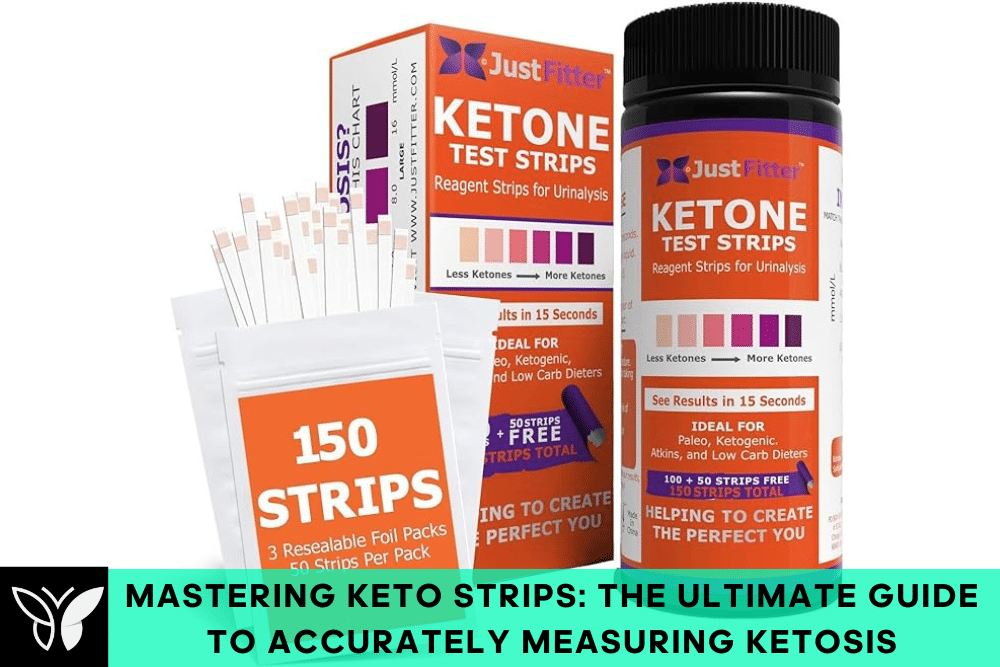The ketogenic diet, a nutritional regimen rich in fats, moderate in proteins, and low in carbohydrates, has gained notable attention for its effectiveness in weight loss and health improvement. By altering the body’s primary energy source from carbohydrates to fats, this diet induces a metabolic state known as ketosis. In ketosis, the body efficiently burns fat for energy, leading to several potential health benefits, including enhanced weight management, improved brain function, and stabilised blood sugar levels. This article will unravel the ultimate list of keto-friendly foods you can freely eat to ensure you are still on track to your diet goals.
Understanding which keto-friendly foods to prioritise is crucial for maintaining ketosis and reaping the ketogenic diet’s full benefits. The right balance of macronutrients—specifically, a high intake of healthy fats, a moderate amount of proteins, and a minimal consumption of carbohydrates—is essential for sustaining this metabolic state. This careful selection of keto-friendly foods supports the body’s transition into and maintenance of ketosis and ensures a nutritious and balanced approach to this low-carb lifestyle. Hence, knowing the foods that align with these macronutrient goals is fundamental for anyone embarking on or sustaining a ketogenic diet.
Critical Principles of Keto Dieting

The ketogenic diet operates on a precise balance of macronutrients to shift the body into ketosis, which burns fat for fuel instead of carbohydrates. The typical macronutrient ratios essential for fostering this metabolic state involve consuming high amounts of fats (about 70-75% of total daily calories), moderate protein (20-25%), and very low carbohydrates (5-10% or 20-50 grams per day). Achieving these ratios is crucial for the body to enter and remain in ketosis, thus maximising the diet’s metabolic benefits.
‘Eating freely’ on a keto diet doesn’t mean unlimited consumption but rather emphasises choosing foods that align with these macronutrient guidelines without exceeding carbohydrate limits. It encourages individuals to focus on high-fat, low-carb keto-friendly foods that support ketoses, such as healthy fats, leafy greens, and quality proteins, while enjoying these within their daily macronutrient targets. This approach allows for a varied and enjoyable diet that can be sustained long-term, offering flexibility within keto’s nutritional principles. Understanding and adhering to these key principles is fundamental for anyone looking to navigate the ketogenic diet successfully and achieve their health and wellness goals.
Categories of Keto-Friendly Foods
Each section below will highlight keto-friendly foods you can eat freely, focusing on their benefits and how they fit into a keto diet.
1. Healthy Fats

The first on the list of keto-friendly foods is Healthy Fats. Including Avocado, Olive Oil, Coconut Oil, and MCT Oil in your diet is crucial. Avocados are rich in monounsaturated fats and contain vitamins, minerals, and fibre. Olive oil, a staple in heart-healthy diets, includes antioxidants and monounsaturated fats, making it excellent for cooking or dressing salads. Coconut oil and MCT (Medium Chain Triglycerides) oil are unique in their ability to be rapidly absorbed and metabolised by the body, providing a quick source of energy and facilitating ketosis.
Why Healthy Fats are Foundational to Keto
The ketogenic diet relies on fat as its primary energy source, replacing carbohydrates. This shift not only helps to induce ketosis but also sustains it, allowing the body to burn fat for fuel efficiently. Healthy fats play a crucial role in this process, providing long-lasting energy, aiding in the absorption of fat-soluble vitamins, and contributing to a sense of fullness, which can help control appetite. Incorporating a variety of these healthy fats into your diet ensures you receive a broad spectrum of nutrients while adhering to the keto-macronutrient ratios, making them foundational to the ketogenic lifestyle.
2. Proteins

Proteins are second on the list of keto-friendly foods. Opting for Grass-fed Meat, Poultry, Fish, and Seafood ensures you’re consuming high-quality proteins rich in omega-3 fatty acids, crucial for muscle health and overall wellness, while keeping carb intake minimal. When chosen with lean cuts in mind, poultry provides high protein content without excessive fat. Fish and seafood are excellent protein sources, rich in omega-3 fatty acids crucial for heart health and cognitive function. These sources support the macronutrient needs of a ketogenic diet and contribute to a nutrient-dense intake.
Importance of High-Quality, Lean Protein Sources
Opting for high-quality, lean proteins is essential on a keto diet to ensure you’re getting sufficient protein without exceeding fat or carb limits, especially if your fat intake comes from other sources in the diet. These proteins support muscle health and repair, satiety, and overall bodily functions without compromising the state of ketosis. Individuals can maintain a balanced and healthy ketogenic diet by focusing on these nutritious protein sources, optimising weight loss and muscle preservation.
3. Low-Carb Vegetables
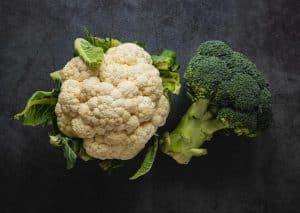
Third on the list of keto-friendly foods are Low-Carb Vegetables. Leafy greens like spinach, kale, and Swiss chard are packed with vitamins A, C, and K and minerals like magnesium and calcium, all while low in carbohydrates. Cruciferous vegetables, including broccoli, cauliflower, and Brussels sprouts, offer fibre and vitamins C, E, and K and are known for their cancer-fighting properties. Other Non-Starchy Veggies such as zucchini, bell peppers, and asparagus provide a variety of textures and flavours to meals without adding many carbs, making them perfect for maintaining ketosis.
Tips for Incorporating a Variety of Vegetables
- Mix and Match in Meals: Combine different vegetables in salads, stir-fries, and casseroles to enhance flavour and nutritional content.
- Use as Carb Substitutes: Employ vegetables like cauliflower as a low-carb substitute for rice, mashed potatoes, and zucchini spirals instead of pasta.
- Snack Wisely: Opt for raw or lightly steamed vegetables with keto-friendly dips like guacamole or a high-fat dressing for a nutritious snack.
- Experiment with Cooking Methods: Roasting, grilling, and sautéing can bring out unique vegetable flavours, making them more appealing and adding variety to your diet.
- Season Well: Use herbs and spices to season vegetables, boosting their taste without adding extra carbs.
4. Dairy Products

Fourth, Dairy Products make the list of the top keto-friendly foods. Full-fat Cheese, Butter, and Heavy Cream are excellent sources of healthy fats, calcium, and vitamins A, D, and K2. Cheese offers a range of options, from soft to hard, providing versatility in keto cooking. Butter, especially when grass-fed, is rich in omega-3 fatty acids and butyrate, a short-chain fatty acid beneficial for gut health. Heavy cream can add richness to coffee, soups, and sauces, making it a staple in many keto kitchens.
Moderation and Choosing the Best Dairy Options
While dairy can be a beneficial part of a keto diet, moderation is vital due to its calorie density and potential to contribute to sensitivities in some individuals. Here are some tips for incorporating dairy wisely:
- Opt for High-Quality: Choose organic and grass-fed dairy products where possible, as they contain higher omega-3 fats and fat-soluble vitamins.
- Moderation is Key: Even full-fat dairy products contain some carbs, so monitoring your intake to ensure it fits within your daily carb limit is essential.
- Be Mindful of Sensitivities: Some people may find they are sensitive to dairy. Consider reducing your dairy intake if you experience bloating, gas, or other digestive issues.
- Focus on Nutrient-Dense Options: Prioritise dairy products that offer the most nutritional bang for your buck, such as aged cheeses and cultured butter, which can provide additional probiotics and enzymes.
5. Nuts and Seeds
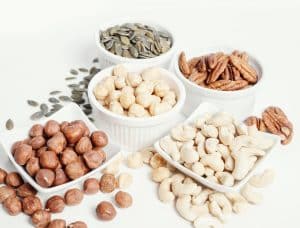
Fifth, Nuts and Seeds are indispensable in the top keto-friendly foods. Almonds are high in vitamin E, magnesium, and protein, making them an excellent snack for energy and heart health. Walnuts are known for their omega-3 fatty acid content, which supports brain health and reduces inflammation. Flaxseeds are a powerhouse of fibre and omega-3 fats, beneficial for digestion and cardiovascular health. Chia Seeds pack a substantial amount of fibre, omega-3s, and calcium into a small serving, perfect for boosting nutritional intake without adding many carbs.
Nutritional Benefits and Mindful Consumption
While nuts and seeds are keto-friendly, they are also calorie-dense, so mindful consumption is crucial to avoid unintentional overeating. Here are some tips for incorporating them into your diet effectively:
- Portion Control: Measure servings to prevent calorie overload. A small handful (about 1 ounce or 28 grams) is a good serving size for nuts and seeds.
- Incorporate Variety: Rotate different types of nuts and seeds in your diet to benefit from their varied nutritional profiles.
- Use as Toppings and Ingredients: Instead of eating them alone, add nuts and seeds to salads, yoghurt, or keto-friendly baked goods to enhance texture and nutritional content.
- Opt for Raw or Roasted: Choose raw or dry-roasted nuts without added sugars or vegetable oils to keep your snack as healthy as possible.
6. Eggs

Eggs make the sixth list of the top keto-friendly foods. Eggs can be prepared in numerous ways, making them incredibly versatile. They can be boiled, scrambled, poached, or made into omelettes and frittatas, each method offering a different texture and flavour profile to keep meals interesting. Eggs also serve as a binding agent in keto-friendly baking, helping to create low-carb bread, pancakes, and other baked goods. Their adaptability ensures that eggs can fit into virtually any meal, providing a nutrient-dense food option that supports ketosis.
Cooking Tips
- For added flavour and nutrients, cook eggs in healthy fats like butter or coconut oil.
- Incorporate vegetables and high-quality meats into omelettes and frittatas to increase the nutritional value of your meal.
- Experiment with herbs and spices to enhance the natural flavour of eggs without adding extra carbs.
Nutritional Highlights:
- Eggs are one of the few foods naturally rich in vitamin D, vital for immune function and bone health.
- They contain choline, an essential nutrient for brain health that many people don’t get enough of.
- The high-quality protein in eggs is perfect for muscle repair and growth, making them ideal for post-workout meals.
- Eggs contain antioxidants like lutein and zeaxanthin, which are crucial for eye health.
7. Berries (in Moderation)
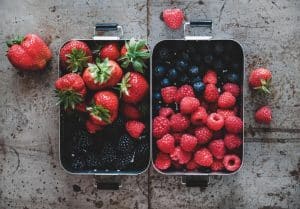
Seventh on the list of top keto-friendly foods are Berries, which should be eaten in moderation. Raspberries, Blackberries, and Strawberries are lower in carbs than other fruits, making them an excellent choice for adding sweetness and a wealth of nutrients to your diet. These berries are high in fibre, which can help reduce the net carb count, making them more keto-friendly. They are also rich in antioxidants, vitamins, and minerals, supporting overall health and wellness.
How to Enjoy Sweet Flavours on Keto
- Portion Control: Measure your servings to ensure you stay within your daily carb limits. A small handful or about a half-cup serving can satisfy sweet cravings without adding too many carbs.
- Pair with Cream: Combine berries with full-fat whipped cream or Greek yoghurt for a delicious, keto-friendly dessert that adds fat to help you stay in ketosis.
- Use as Toppings: Sprinkle a few berries on keto pancakes, waffles, or cereal to enhance flavour without overloading carbs.
- Make Smoothies: Blend berries with spinach, avocado, and a keto-friendly liquid like unsweetened almond milk for a nutrient-packed smoothie that keeps carbs in check.
- Create Sauces and Jams: Cook berries with a keto sweetener to make a low-carb sauce or jam that can be drizzled over keto desserts or added to plain yoghurt.
8. Beverages

Beverages take the last spot of the top keto-friendly foods. Water is essential for staying hydrated and should be your primary go-to drink. It’s necessary for every bodily function and can help manage feelings of hunger and maintain energy levels.
Herbal Teas offer a comforting, calorie-free way to stay hydrated throughout the day. Available in various flavours, herbal teas can also provide multiple health benefits, from calming the nerves to aiding digestion.
Black Coffee is another excellent option for those on a ketogenic diet. Rich in antioxidants and free from carbs, black coffee can boost energy levels and concentration. Just be sure to enjoy it without sugar or high-carb creamers.
Bone Broth is a nutritious option that provides hydration, valuable minerals, and electrolytes, which are especially important during the initial stages of ketosis when the body adjusts to the diet.
Importance of Hydration and Low-Carb Drink Options
Staying well-hydrated is vital on keto, not just for health and well-being but also for ensuring the diet’s effectiveness. Dehydration can lead to fatigue, headaches, and other unwanted symptoms hindering your progress. By choosing low-carb drinks like water, herbal teas, black coffee, and bone broth, you can maintain hydration without adding unnecessary carbs to your daily intake.
Foods to Limit or Avoid on a Ketogenic Diet

On a ketogenic diet, maintaining ketosis is crucial for achieving the desired health benefits, including weight loss and improved metabolic health. This requires careful management of your carbohydrate intake and an understanding of which foods to limit or avoid. High-carb foods can quickly disrupt ketosis, taking your body out of its fat-burning state.
High-Carb Foods to Limit or Avoid
- Sugary Foods: Candy, soda, fruit juice, and desserts are high in sugars and can significantly increase your carb intake, disrupting ketosis.
- Grains and Starches: Bread, pasta, rice, cereals, and other wheat-based products are high in carbohydrates and should be avoided on a keto diet.
- Starchy Vegetables: Potatoes, sweet potatoes, and other root vegetables are high in carbs and can hinder your progress.
- Legumes: Beans, lentils, and chickpeas are nutritious but high in carbs, making them less ideal for a ketogenic diet.
- Fruit: Most fruits, except for small portions of berries, are high in sugars and carbs.
Strategies for Navigating Social Situations and Cravings
- Plan Ahead: If you know you’ll attend a social event, consider eating beforehand or bringing keto-friendly foods or snacks to avoid temptation.
- Find Alternatives: For cravings, seek out low-carb alternatives that satisfy the need for something sweet or crunchy without the high-carb count.
- Stay Hydrated: Sometimes, thirst is mistaken for hunger or cravings. Drinking water or a keto-friendly beverage can help curb cravings.
- Be Open About Your Diet: Explain your dietary choices when dining with friends or family. Most people are willing to accommodate or at least understand your needs.
- Focus on What You Can Eat: Concentrate on the variety of keto-friendly foods you can enjoy on keto rather than what you’re missing out on. This positive mindset can help reduce cravings and simplify navigating social situations.
By understanding which foods to limit or avoid and implementing strategies to deal with social situations and cravings, you can maintain a ketogenic lifestyle more effectively and enjoy the benefits of staying in ketosis.
Conclusion on the Ultimate Guide to Keto-Friendly Foods
The ketogenic diet is not just a pathway to weight loss and improved metabolic health; it’s a journey into a diverse and nutritious culinary world. From the heart-healthy fats found in avocados and olive oil to the lean proteins in grass-fed meats and the antioxidant-rich colours of low-carb vegetables, keto offers a palette for creating meals that are as nourishing as they are delicious. Including eggs, nuts, seeds, and select dairy products further enriches this diet, providing a balanced mix of essential nutrients for optimal health.
Moreover, strategically using berries and keto-friendly beverages adds a layer of enjoyment, ensuring that your diet remains hydrated, varied, and satisfying. While there are foods to limit or avoid, focusing on what you can eat freely opens up a world of culinary creativity.
